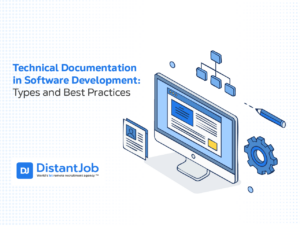Right now, we’re experiencing an unprecedented level of work and life disruption that includes remote working by necessity.
Although dealing with distractions is a large part of remote working, where there’s a will – or a necessity – there’s also a way.
Studies show that remote workers are 25-40% more productive than those remaining in a traditional work environment – if they have the right mindset, tools, and company support.
Blending home life and work-life can be hard at times, with children having their demands, or getting extended family to understand that being at home doesn’t mean you are free to talk on the phone or drop everything for a visit.
Many employees are facing such circumstances right now (minus the impromptu visits), in addition to feeling a great deal of fear and uncertainty about the future.
The Impact of Distractions on Remote Employees
Hiring remote workers opens the door to numerous benefits, enriching your team with diversity, talent, and flexibility. Yet, transitioning to remote management brings its own set of hurdles, albeit manageable ones.
The question isn’t whether employees can remain productive in a remote setting—because they certainly can—but rather how they navigate the inevitable distractions that accompany remote work. Achieving a productive flow is crucial for any worker, as distractions can significantly disrupt this rhythm, leading to prolonged periods of decreased productivity.
Consider the impact of seemingly minor interruptions: a brief message or an unexpected call can derail someone’s focus, sometimes for up to 15 minutes following a mere 2-second distraction. Doubling this interruption can extend recovery time even further. The implications are significant, with studies indicating that interrupted tasks not only take longer to complete but are also prone to a higher error rate. In fact, it’s estimated that interruptions affect around 57% of any given task, allowing for only about 2 hours of uninterrupted work each day.
Remote employees, however, hold an advantage. They have the autonomy to tailor their work environment to minimize distractions—a liberty that can vastly improve focus and efficiency. As a manager, your role is to support this process, ensuring that your remote team members can thrive under the same expectations set for in-office staff. This doesn’t mean your existing rules can’t be adjusted; on the contrary, fine-tuning your workflow to accommodate both remote and onsite employees can yield significant benefits for all involved.
So, how can we optimize our workflow to support the unique needs of remote work? By understanding and addressing the challenges of remote work distractions, we can create a more productive and focused work environment for everyone, regardless of where they log in from.
Top 5 Strategies for Managing Distractions in Remote Work
First-time remote workers might find it difficult to minimize the onslaught of distractions while working from home. On the other hand, those who already have the experience of working remotely might be facing some new challenges they didn’t have to deal with before.
Here are 5 tips to reduce those distractions as much as possible:
1. Get The Family on Board
One difference between typical work-from-home scenarios and what we’re facing now is that school-age children are also home all day. They may need to use the same technology as you to keep up with their school work or simply expect to be entertained.
Try to set up a dedicated time and space in your home that’s for work. Older children and spouses can help with household duties and care of younger kids while you’re at work.
2. Detach from the Bustle
If you’re lucky enough to have a room with a door, hang a “Do Not Disturb” sign. Let the family know that when that door is closed, you’re at work.
For those who are forced to work at the kitchen table or other common areas of the home, try to schedule any work that requires focus during quiet times, even if that means working after the family goes to bed at night or before they wake up in the morning.
3. Let Technology Help
If noise is a common source of distraction, noise-canceling headphones are a worthwhile investment.
The Bose QuietComfort model is great — both the older model and the new one. Sony WHX1000XM3 is also decent, even better if you like to listen to music in the background, as the noise cancellation is somewhat lower than with Bose models.
As far as other technology goes, many companies are finding it a good investment to purchase tablets or laptops that employees can use at home and phones to keep in touch. This also provides the benefit of making sure that everyone is working with the same apps and platforms.
If you’re sharing the family PC, buying a laptop or creating a formal schedule will be necessary.
4. Prioritize
Some distractions and stressors are self-imposed. You can become overwhelmed by stuffing your to-do list with too many things.
Try to prioritize and focus on one task at a time. If you have a large project to complete, break it down into bite-sized chunks and tick them off of your list as you finish each mini-goal. The feeling of accomplishment as the list gets smaller is energizing!
5. Socialize (Moderately)
Not all distractions come from inside the house.
Many workplaces are also social environments. We’re used to popping into someone’s office several times a day or gathering in the break room.
However, the feelings of isolation, or sheer boredom, can turn to bombarding co-workers with unnecessary emails and calls. Don’t be that guy (or girl).
The good thing about emails is that you can answer them on your schedule. Just make sure to read the subject lines, so you don’t miss a critical communique. The same is not true of more immediate interruptions like calls, texts, and other instant messaging platforms.
When this becomes a problem that’s affecting your ability to get your work done, you can set a “do not disturb” status on messaging tools or temporarily mute calls and texts. Business leaders can take the onus off of their employees by making this a policy during certain hours if need be.
How Business Leaders Can Help
Many employers and staff members worry about maintaining productivity on the job while working from home.
As a company leader, it’s up to you to ensure that your employees have the tools and support they need to make a successful transition. That means setting guidelines that support productivity and keeping the lines of communication open.
Understanding the challenges your staff is facing at home is part of being an effective leader. That may make it necessary to adjust work schedules and deadlines whenever possible. You can also educate staff members about apps and utilities that contribute to productivity.
Technology plays a big part in this.
In addition to providing the equipment your staff needs to get the job done, you can help them block distractions in other ways. For example, all browsers and operating systems have utilities that can filter out common distractors like pop-up ads. Remind your staff to enable them.
If the devices they’re working on come from your office, each can be configured ahead of time to block social media sites and networks temporarily.
You can use platforms like Zoom, Slack, and Skype to keep in touch and conduct meetings. It’s essential to schedule regular staff meetings at such a time to keep everyone on the same page and feeling connected. These are also good platforms for interacting with employees one-on-one and promoting teamwork.
Final Thoughts
Remote work is nothing new. It’s the current circumstances that are challenging, putting both managers and employees into uncharted territories with little to no time to prepare.
We hope the above suggestions will help you and your staff get through this challenging time with a minimum of stress and disruption in the remote work world. Remember, we’re all in this together, even when we’re apart.




